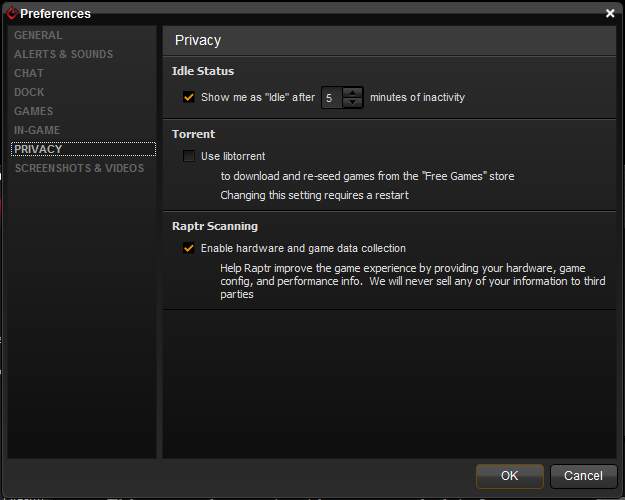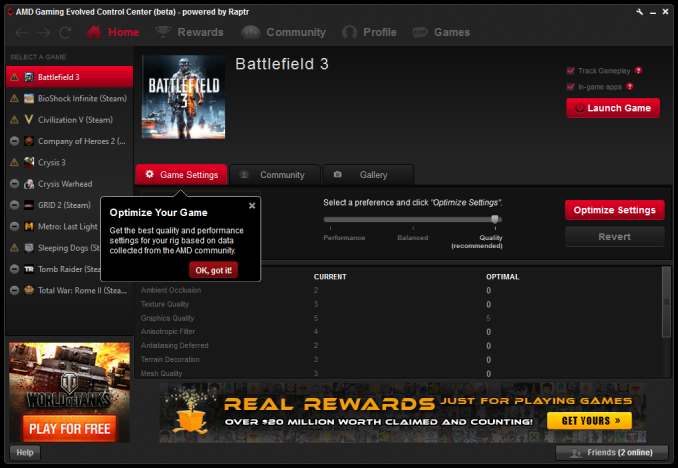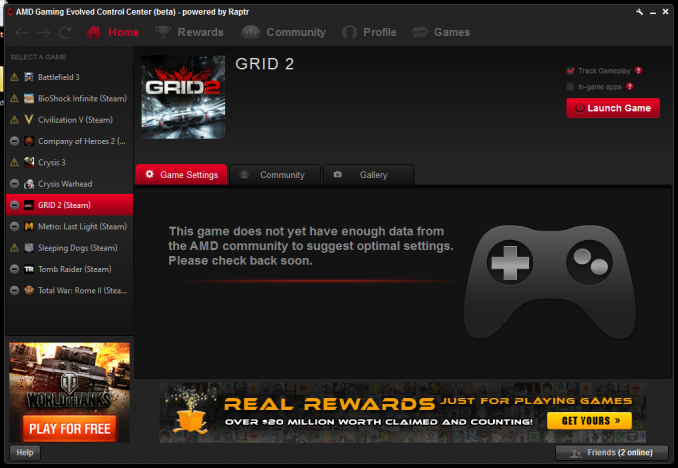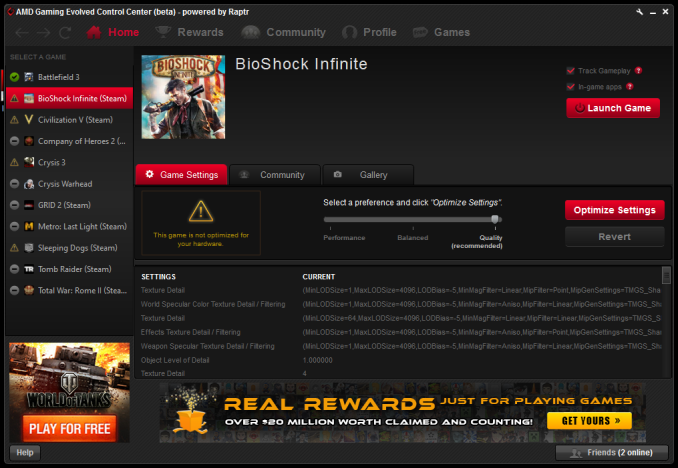The AMD Radeon R9 290 Review
by Ryan Smith on November 5, 2013 12:01 AM EST- Posted in
- GPUs
- AMD
- Radeon
- Hawaii
- Radeon 200
AMD's Gaming Evolved Application
During AMD’s “partner time” block at the 2014 GPU Product Showcase, one of the projects presented was the Raptr social networking and instant messaging application. Put together by the company of the same name, AMD would be partnering with Raptr to produce an AMD branded version of the utility called the “AMD Gaming Evolved App, Powered By Raptr”.
In a nutshell, the Gaming Evolved App (GEA) is AMD’s attempt to bring another value add feature to the Radeon brand. And although AMD will never explicitly say this, to be more specific the GEA is clearly intended to counter NVIDIA successful GeForce Experience utility, which exited beta back in May and has been continuing to add features since.
Raptr/GEA contains a wealth of functionality, with the application being several years old at this point, but the key feature as a video card utility and the reason AMD has picked it up is its latest feature addition, the game optimization service. Just launched last month in beta, the optimization service is a functional clone of GeForce Experience’s optimization service. Designed with the same goals in mind, the GEA optimization service is intended to offer the ability for gamers disinterested in configuring their games – or even just looking for a place to start – a way to simply download a suitable collection of settings for their games and hardware and apply those settings to their games.
The concept is in practice very similar to the recommended settings that most games apply today, but driven by the GPU manufacturer instead of the game developer, and kept up to date with hardware/software changes as opposed to being set in stone when the game went gold. Even for someone like a professional GPU reviewer, it’s a very nifty thing to have when turning up every setting isn’t going to be practical.
To get right to the point then, while we’re big fans of the concept it’s clear that this is a case of AMD tripping over themselves in trying to react to something NVIDIA has done, by trying to find the fastest way of achieving the same thing. Like GeForce Experience, AMD has started bundling GEA with their drivers and installing it by default, but unlike GFE it’s still in beta at this point, and a very rough beta at that. And not to take an unnecessary shot at AMD, but even in beta GeForce Experience wasn’t this raw or this incomplete.
So why are we so down on GEA? There are a few reasons, but the most basic of which is that the Raptr service lacks enough performance data for GEA to offer meaningful recommendations. Even on a fairly old card like a Radeon HD 7950, GEA was only able to find settings for 5 of the 11 games we have installed on our GPU testbed, failing to include settings for a number of games that are months (if not years) old. To be fair every service has to start out somewhere, and GFE certainly didn’t launch with a massive library of games, but 5 games, none newer than March, is a particularly bad showing.
Now a lot of this has to do with how Raptr collects the performance data it uses for recommendations. NVIDIA for their part decided to do everything in house, relying on their driver validation GPU farms to benchmark games across multiple settings to find a good balance based on parameters picked by the GFE development team. Raptr, though backed by AMD, does not have anything resembling NVIDIA’s GPU farms and as such is going the crowdsourced route, relying on telemetry taken from Raptr users’ computers. Raptr’s data acquisition method is not necessarily wrong, but it means there’s no one to bootstrap the service with data, which means the service has started out with essentially nothing.

Raptr for their part is aware of the problem they’re faced with, and in time the distribution of the GEA along with their own Raptr application will hopefully ensure that there are enough users playing enough games out there to collect the necessary data. Even so, they did have to implement what amounts to a solution to the tragedy of the commons problem to make sure that data gets collected; users cannot receive settings from the Raptr service unless they provide data in return. Turning off the telemetry service will also turn off the client’s ability to pull down settings, full stop. Given the service’s requirements for data collection it’s likely the best solution to the problem, but regardless we have to point out that Ratpr is alone in this requirement. NVIDIA can offer GFE without requiring performance telemetry from users.
Moving on then, the other showstopper with GEA’s current optimization service is that it’s obvious the UI has been an afterthought. The GEA UI lists settings by the values used in a game’s settings file, rather than the name of that value. E.g. “Ultra” texture quality in Bioshock Infinite is labeled as texture detail “4”, or worse. Without sufficient labeling it’s impossible to tell just what those settings mean, let alone what they may do. As such applying GEA settings right now is something of a shot in the dark, as you don’t know what you’re going to get.
Finally, presumably as a holdover from the fact that Raptr is free, GEA runs what can only be described as ads. These aren’t straight up advertisements, rather directing users towards other services Raptr/GEA provides, such as Free-2-Play games and a rewards service. But the end game is the same as these services are paid for by Raptr’s sponsors and are intended to drive users towards purchasing games and merchandise from those sponsors. Which far be it for us to look down upon advertisements – after all, AnandTech is ad supported – but there’s something to be said for ad supported applications in a driver download. We're at something of a loss for explaining why AMD doesn't just foot the complete bill on their customized version of the Raptr client and have the ads removed entirely.
At any rate we do have some faith that in time these issues can be dealt with and the GEA can essentially be fixed, but right now the GEA is far too raw for distribution. It needs to go back into development for another few months or so (and the service bootstrapped with many more computer configurations and games) before it’s going to be of suitable quality for inclusion in AMD’s drivers. Otherwise AMD is doing their users a disservice by distributing inferior, ad supported software alongside the software required to use their products.
The Test
For the launch of the Radeon R9 290, the press drivers and the launch drivers will be AMD’s recently released Catalyst 13.11 Beta v8 drivers. Along with containing support for the 290 and the 47% fan speed override, the only other changes in these drivers involve Batman: Arkham Origins and Battlefield 4, games which we aren’t using for this review. So the results will be consistent with past drivers. Meanwhile for NVIDIA’s cards we’re continuing to use their release 331.58 drivers.
| CPU: | Intel Core i7-4960X @ 4.2GHz |
| Motherboard: | ASRock Fatal1ty X79 Professional |
| Power Supply: | Corsair AX1200i |
| Hard Disk: | Samsung SSD 840 EVO (750GB) |
| Memory: | G.Skill RipjawZ DDR3-1866 4 x 8GB (9-10-9-26) |
| Case: | NZXT Phantom 630 Windowed Edition |
| Monitor: | Asus PQ321 |
| Video Cards: |
AMD Radeon R9 290X AMD Radeon R9 290 XFX Radeon R9 280X Double Dissipation AMD Radeon HD 7970 GHz Edition AMD Radeon HD 7970 AMD Radeon HD 6970 AMD Radeon HD 5870 NVIDIA GeForce GTX Titan NVIDIA GeForce GTX 780 NVIDIA GeForce GTX 770 |
| Video Drivers: |
NVIDIA Release 331.58 AMD Catalyst 13.11 Beta v1 AMD Catalyst 13.11 Beta v5 AMD Catalyst 13.11 Beta v8 |
| OS: | Windows 8.1 Pro |













295 Comments
View All Comments
chizow - Tuesday, November 5, 2013 - link
It's really strange what AMD has done with the 290. Sure it has great price and performance, but AMD has also ramped it up in the key complaint areas, power and noise to get there. As a result, the performance of the 290 is close enough to the 290X that you have to wonder if AMD even wants to sell any 290Xs at all. They are hard enough to find to begin with, but at a $150 price difference for ~5% difference in performance, it seems as if AMD is cannibalizing their own SKUs and dissuading people from purchasing the 290X and choosing the much cheaper 290 instead. It also comes close enough to the 280X while thoroughly stomping it to make the 280X seem much less attractive in that $300-$400 range.In the end the 290 seems like a strong buy for anyone who is willing to tolerate the heat and the noise. It's amazing that the 290 is even hotter and louder than the 290X, even taking the crown from the previous high-end, noisy fireball GTX 480 (thanks for including it in these results this time btw). It's certainly possible AMD wants this SKU to sit by itself in that $400 slot, safely away from the 770/280X below it and the GTX 780/290X above it.
dragonsqrrl - Tuesday, November 5, 2013 - link
The GTX480 is not the previous 'noisy fireball'. AMD has introduced many cards since that make the 480 seem downright reasonable. Take the 6990 and 7970GHz for example. AMD has gone so far and beyond Nvidia in terms of heat and noise it seems comical to still hear people talk about the 480 as though it's some kind of benchmark to compare these cards against. The stock coolers on these recent gen high-end cards from AMD have been much louder.HisDivineOrder - Tuesday, November 5, 2013 - link
Everyone who knows anything knows the FX5800 is the benchmark of loud cards. Seriously, that thing was, is, and will always be the Leaf Blower of Legend.That said, the 290 is a very well executed attempt to catch the myth and make real the loud card of lore we once thought dead and gone.
creed3020 - Tuesday, November 5, 2013 - link
LOL, I too remember the term Leaf Blower being used with the FX5800 for the first time. A friend had it in his rig and we couldn't stop bugging him about it. This was coming from another friend who have three 80 mm Antec Tornados in his case!chizow - Tuesday, November 5, 2013 - link
Agreed that the 480 was probably not as loud, it's fan had issues but didn't have the same high pitched whine characteristic of AMD's blowers. But it was the previously hottest, highest power consuming single-GPU and as an owner of 2 in SLI I can say for sure the heat was a lot to deal with.Mariosti - Tuesday, November 5, 2013 - link
Now think about this:290X with new drivers, and proper cooling enabling it not to just "not throttling" but also to get some minor oc. The difference will be much bigger. That's why nvidia must go all the way with GK110 unlocking to make the 780Ti a viable competitor.
TheJian - Tuesday, November 5, 2013 - link
Or NV can just OC their cards until they hit another 10DB or 50-70watts and laugh right? This is all AMD has done. Why didn't AMD just include this magical fan in the ref design? Overclocks show there isn't much in the tank either. Don't forget they're using NV ref here also. You can buy OC cards that are already clocked 10%+ faster out of the box and reviews show they are quiet in comparison which NOBODY buys.jnad32 - Tuesday, November 5, 2013 - link
The way I look at it, AMD is looking like an absolute genius. Everyone was ripping them on the 290X for it being too hot and too loud anyway. So instead of keeping the sound levels down they just went for what they do best, price/performance. They are now blowing every other card out of the water. There isn't a card on the planet that can touch this card in price/performance. Yea its loud as hell but, at least you have to think about it now just because of the price. What I really want to see is them unleash the 290X sound threshold and see what kind of raw numbers it can put up. Lets be honest, the only people who should buy reference cards are the ones who are putting water blocks on them.Dal Makhani - Tuesday, November 5, 2013 - link
hmm seems like this card in a somewhat "uber mode" fan profile cannibalizes AMD's own R9 290X?HanzNFranzen - Tuesday, November 5, 2013 - link
Ok, fine, the reference cooler sucks. But we all know that sooner rather than later there will be several versions with non-reference coolers available. So instead of get 106% of a 780's performance for $100 lees, we will get it for $70 less. (and possibly some more OC headroom?)Any way you slice it, AMD has done a service for all of us enthusiasts no matter if you're an NVidia or AMD fan... The price/performance has come back down to earth. I will be buying one of these cards, no doubt. But I will be waiting to see what Sapphire or Asus come up with as far as cooling or I may just drop for a 3rd party cooler and a reference board.